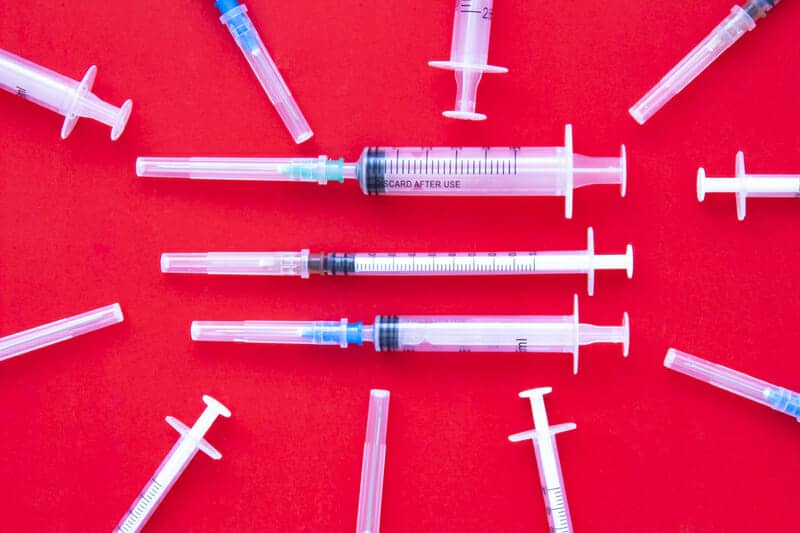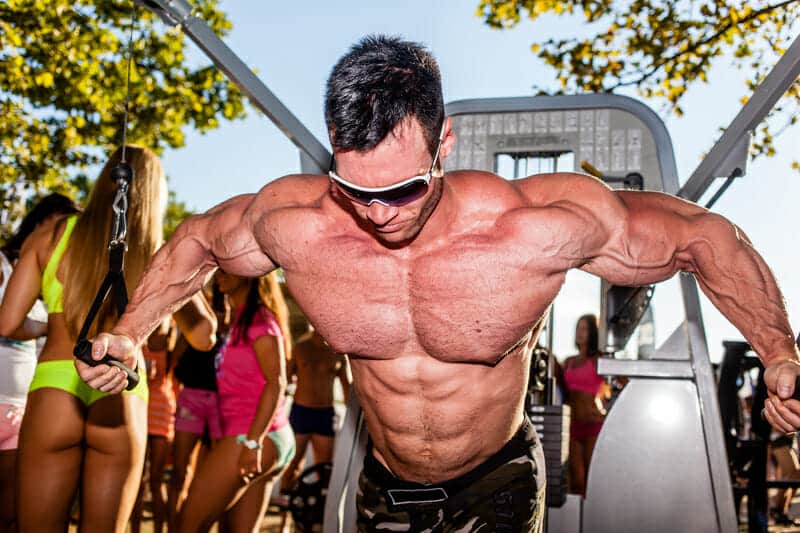Have you ever watched Marvel’s X-Men and wished your body had Wolverine’s healing ability?
As a long-time fan of the franchise back when kids were actively engaged in reading comic books, I know myself – and many other pro-level athletes – would love to have that superpower.
We’re unfortunately far away from having access to medical technology that leads to instant bodily regeneration from injuries and wounds…
… But we do have access to some game-changing therapeutic peptides to help us get there.
This short article is some highly advanced intel for biohackers who want the most fully optimized healing stack in existence.
You’ll discover exactly what peptides for healing you need, how to use them, and when to use them.
Table of Contents
ToggleHow Do Peptides Help With Healing and Injury Repair?

Peptides for injury repair do not do anything “new” to the body; rather, they accelerate the speed and/or efficiency your body’s natural processes for recovery when it sustains damage.
Which means you’ll see each of these peptides work in one of the four major phases of wound healing.
It’s an incredibly complicated topic that’s far beyond the scope of this article, but I’ll share the most important bits with you:
“Haemostasis – establishes the fibrin provisional wound matrix and platelets provide initial release of cytokines and growth factors in the wound.
Inflammation – mediated by neutrophils and macrophages which remove bacteria and denatured matrix components that retard healing, and are the second source of growth factors and cytokines. Prolonged, elevated inflammation retards healing due to excessive levels of proteases and reactive oxygen that destroy essential factors.
Proliferation – fibroblasts, supported by new capillaries [via angiogenesis], proliferate and synthesize disorganized ECM [extracellular matrix]. Basal epithelial cells proliferate and migrate over the granulation tissue to close the wound surface.
Remodelling – fibroblast and capillary density decreases, and initial scar tissue is removed and replaced by ECM that is more similar to normal skin. ECM remodelling is the result of the balanced, regulated activity of proteases.”
Some of these processes may be familiar to you — increasing blood flow, lowering chronic inflammation, etc. — and that’s because a lot of them are similarly involved in reversing hair loss.
Peptides for healing come into play because often times people find themselves unable to go through all four phases in the right sequence and the right amount of time:
“There are many factors that can affect wound healing which interfere with one or more phases in this process, thus causing improper or impaired tissue repair.
Wounds that exhibit impaired healing, including delayed acute wounds and chronic wounds, generally have failed to progress through the normal stages of healing.
Such wounds frequently enter a state of pathologic inflammation due to a postponed, incomplete, or uncoordinated healing process”
And even if the body does everything right, there are situations in life where we want things to go a little faster.
Let’s be honest: No athlete or bodybuilder would shy away from having the ability to recover rapidly from any injury, no matter how severe it is or where it is located.
Faster healing means more time spent in the gym perfecting one’s physique and performance…
… And as souls within a physical vessel subject to the three-dimensional concept of time, time is the most valuable commodity that gets depleted with each passing second.
The Original “Wolverine Healing Stack” Found on the Internet

The Wolverine healing stack was first described by Ben Greenfield across numerous podcasts and articles, but he described it much more thoroughly in his book Boundless:
“I’ve personally used peptides BPC-157 and TB-500 to enhance healing and recovery. BPC-157 (body protection compound 157), which protects and heals the gut, is found in trace amounts in gastric juices… [it] also accelerates wound healing, and, via interaction with the nitric oxide system, protects endothelial tissue and builds blood vessels.”
“TB-500 (also known as thymosin beta-4) is also produced by the human body as well as by various animals. Like BPC-157, it can be synthesized in a lab and used to promote wound repair and healing, particularly because it acts on actin and myosin fibers in tendons, ligaments, and muscles… [and] like BPC-157, TB-500 can be injected in or near any damaged muscle site and sore or injured joint with surprising healing effects”
“…they can act systemically, not just locally, when injected just about anywhere in the body”
Prior to this, he had individual articles dedicated to both BPC-157 and TB-500 (complete with some very useful instructions for reconstituting and safely injecting both peptides).
Since then, there are many peptide physicians who have described both peptides for injury recovery as “the Wolverine healing stack” (such as Dr. Neil Paulvin) along with numerous YouTube channels:
You’ll also see many peptide vendors sell BPC-157 and TB-500 combined into a single injectable formulation, making promises such as:
- Acceleration towards an optimal rate of healing
- Maximum all-natural recovery
- Boosts tissue regeneration and repair
There is some debate over whether it’s better to inject the peptides separately or have them combined in a single injection, but at that point, you’re arguing over very minor details.
However, there is one type of “Wolverine healing stack” you should specifically avoid!
It’s also been brought to my attention that there are nasal sprays on the market combining BPC-157 and TB-500 into a single formulation.
I strongly advise against using those sprays as the bioavailability of both peptides is very poor through this method of dosing.
This has been the observation of myself and many other people, such as here and here (although others claim these sprays have a notable healing effect).
Ben Greenfield even said so himself in a podcast he did with peptides physician Dr. Jean-Francois Tremblay:
“…[Using BPC-157 and/or TB-500] intranasal, or if using oral, you would need to dose with approximately roughly double the amount that you’d use if you were going to use an injectable”
As any beginner-level biohacker knows, the route of administration makes a HUGE difference in the effect profile of any drug:
“Many drugs can be administered orally as liquids, capsules, tablets, or chewable tablets. Because the oral route is the most convenient and usually the safest and least expensive, it is the one most often used. However, it has limitations because of the way a drug typically moves through the digestive tract.
For drugs administered orally, absorption may begin in the mouth and stomach. However, most drugs are usually absorbed from the small intestine. The drug passes through the intestinal wall and travels to the liver before being transported via the bloodstream to its target site.
The intestinal wall and liver chemically alter (metabolize) many drugs, decreasing the amount of drug reaching the bloodstream.
Consequently, these drugs are often given in smaller doses when injected intravenously to produce the same effect”
(BTW, the link above is an absolute must-read if you want to learn the numerous ways in which drugs are administered and why they exist)
This is the same reason why some people argue that the nootropic peptide known as Semax is more effective when subcutaneously injected instead of being administered nasally.
You can argue all day long about how these observed differences are due to multiple factors, but putting aside the rare exception for a few select peptides, injections are almost always more effective when dosing peptides for healing than nasal sprays.
The 4 Best Healing Peptides For Injury Recovery

As much as I love and respect Ben Greenfield, I am upgrading his Wolverine Healing stack right here and now.
Nick Andrews, genius biochemist and Aseir Custom co-founder, has used this modified protocol to successfully heal a sprained knee within 5 days when it normally would have taken 5 weeks.
So without further ado, here is the All New and Improved, Super Deluxe Extended Dub Remix of the “Wolverine Healing Stack” you can choose to use from now on!
BPC-157
Isolated from a larger peptide known as “Body protecting compound” from human gastric juice, the BPC-157 peptide has numerous regenerative effects:
- Healing of muscles, tendons, ligaments, bone, and skin burns
- Increases blood flow through angiogenesis
- Protective of your body’s organs
- Possesses powerful anti-inflammatory properties
You can consider it the OG peptide for recovery amongst all the ones featured in this article (and was in the fact the very first peptide I wrote about prolifically on this website).
However, for the athletes reading this, the World Anti-Doping Agency will consider BPC-157 as a prohibited substance starting on January 1st, 2022:
“Prior to 2022, BPC-157 was not prohibited, but it has been added to the WADA Prohibited List after the annual review of the List and is prohibited starting on January 1, 2022. It’s prohibited under the S0 Unapproved Substances category of the List.”
Don’t say you weren’t warned!
Dose: 250 mcg injected subcutaneously twice a day
TB-500
TB-500 is a naturally-produced peptide found in nearly every single part of the human body.
Through the up-regulation of actin to promote cellular growth and the stimulation of blood cell development, it possesses healing effects that are highly similar to those of BPC-157:
- Repairs damage to the heart, skin, tissue, ligaments, and other organs
- Boosts immunity
- Provides pain relief
- Possesses strong anti-inflammatory properties
TB-500 seems to be the better peptide for muscle repair, whereas BPC-157 shines in treating gastrointestinal disorders.
TB-500 also differs in that there are numerous dosing protocols you can use, which are available in my written article about the peptide.
But unfortunately, just like BPC-157, Ben Greenfield has a strong reminder about athletes avoiding the use of TB-500:
“…unlike BPC-157, TB-500 is absolutely, 100% banned by WADA and most other global sporting organization both in-competition and out-of-competition. You should NOT use this if you are competing in any such sanctioned sport as it definitely falls under the banned category of Peptide Hormones, Growth Factors, Related Substances and Mimetics (S2).”
Dose: 2.0-2.5 mg injected subcutaneously or intramuscularly every other day
Ipamorelin and Tesamorelin
Where my revised “Wolverine healing stack” gets an upgrade is in the form of these two additional peptides for healing.
Both Ipamorelin and Tesamorelin improve all aspects of tissue regeneration and healing through the increased production of human growth hormone (GH).
“We currently know that growth hormone (GH) is a pleiotropic factor capable of acting positively in many organs and tissues. For years, the use of GH for wound healing has been investigated.
For example, the use of recombinant human GH as an anabolic treatment in burns to accelerate wound healing is already classic. Patients with severe burns who were treated with systemic GH improved both their healing and their survival.
More recently, a number or studies have shown that GH is a promising agent in the acceleration of wound healing”
“Angiogenesis plays a key role during the granulation phase and tissue remodeling, as new vessels are required for the progression of wound healing… GH can act directly on endothelial cells through the GHR, or indirectly, by increasing others growth factors such as VEGF, FGF, or SDF-1”
Tesamorelin is a growth hormone-releasing peptide (GHRP) and Ipamorelin is a growth hormone-releasing hormone (GHRH), both of which act synergistically to maximize GH production and usage.
The way to think about this is through an analogy to a gas tank, as described by Nick Andrews:
“When you fill up a gas tank, you usually never fill it up all of the way – perhaps 3/4ths of the way. Similarly, when your body goes through its normal cyclical processes and releases GH, it does not release all of it. Everyone produces a natural amount of GH at a baseline level.
Your body fills up your “GH tank” 75% of the way (mostly while sleeping [source]), and then only empties it down to 25%… not all of the way.
Ipamorelin tells your body ‘No no, put out ALL the GH we have available’. Tesamorelin says ‘Release GH, but fill the tank up all the way’.
So by using both peptides, you fill your body’s “GH tank” all the way when it normally wouldn’t with Tesamorelin, and Ipamorelin increases the amount of GH released”
Now you may be wondering… why not just use HGH itself instead of using the two peptides mentioned?
It’s a bad idea for numerous reasons, as exogenous HGH abuse and misuse can:
- Promote unnatural HGH levels and possibly shut down your body’s natural production of HGH, which means your body’s HGH levels drop when you stop injecting HGH
- Negatively impact pituitary function and increase your risk of developing tachyphylaxis
- Lead to side effects such as excess bone growth and excess pituitary gland growth
- HGH is very difficult to obtain due to its status as a controlled substance, and its high price tag will set you back hundreds – if not thousands – of dollars a month (unless you use my recommended source)
We opt for the peptides instead because they will not interfere with your body’s natural production of GH when used at appropriate doses.
Ipamorelin and Tesamorein merely act on the signaling system that tells your body to make more GH.
Just like therapeutic testosterone, your body likes to keep its hormones at a balanced level.
When you inject testosterone exogenously (i.e. the additional testosterone comes from outside the body), the body no longer sees the need to make it… and the same thing happens with GH.
Hence, when we use these two peptides for injury in combination, the body does not detect exogenous GH and respond by producing less of it.
One last thing: These two peptides are also banned by WADA under category “S2: Peptide hormones, growth factors, related substances and mimetics”.
Ipamorelin dose: 200-300 mcg injected subcutaneously 1-3 times a day
Tesamorelin dose: 1 mg right before bed yet 90 minutes after your last meal, and 1 mg upon waking yet ideally before exercise (via subcutaneous injection)
GHK-Cu
I’ve already written about the copper peptide GHK-Cu and its healing capabilities, but here’s a brief reminder of what this potent little molecule can do:
- Increases collagen production and act as “feedback signal” for tissue remodeling
- Suppresses chronic inflammation
- Repairs damaged DNA
- Re-ignites the fixing of protective skin barrier protiens
Now to be clear, this won’t have the same effect as the other four peptides as GHK-Cu won’t help you heal bone damage.
So if you break a rib doing high-contact martial arts, GHK-Cu won’t be useful because there’s no significant soft tissue damage and/or swelling.
But for something like a sprained and swollen ankle (a soft tissue injury), or a skin injury, GHK-Cu can indeed be a big help and arguably the best peptide for inflammation reduction.
First, GHK-Cu is effective in pain reduction: If you’re at a 7 out of 10 in terms of how painful an injury is (10 being maximum pain), this peptide can take it down to a 5 out of 10.
Second, and I want to re-emphasize this, GHK-Cu comes in handy for reducing inflammation: TB-500, BPC-157, and GHK-Cu will all have this effect but through separate biological pathways.
This is NOT equivalent to taking a “triple dose”, so make sure you have that distinction in mind.
Dose: 2-4 pumps (0.21 – 0.84 mL) of a 3% topical formulation gently massaged for 30 seconds
How to Use Peptides for Muscle and Joint Repair

For virtually any injury (except for GHK-Cu), you have the option of injecting these peptides for healing either locally (at the site of injury) or systemically (any other part of the body).
This will HIGHLY vary depending on the nature and the location of the injury you are attempting to heal.
For instance: If someone without significant muscle mass has an ankle injury, it would be very difficult to do an intramuscular injection without accidentally hitting a blood vessel.
Whereas if you simply messed up your shoulder through intense weightlifting, an intramuscular injection is as easy as pie.
Additionally, you may find it prudent to divide up your injections where some of them are intramuscular and some of them are subcutaneous.
I say this because it may be very uncomfortable for some people to do a lot of injections into one area of the body (60-100 units total for all four injectable peptides is A LOT).
There are multiple ways to go about this – for example, you can do a local and intramuscular injection of TB-500 and BPC-157, while doing a systemic and subcutaneous injection of both Ipamorelin and Tesamorelin.
(This gets into extremely arcane territory, as there is always a trade-off depending on the specific combination of injections you use)
But I can make some general recommendations about these peptides for injury repair:
- Tesamorelin and Ipamorelin should be injected systemically because the signaling receptors they need to reach are in the brain and other parts of the body, and are most likely not at the site of the injury
- BPC-157, TB-500, and GHK-Cu are best injected/used locally
Finally, we also have to factor in the half-life of each peptide.
The half-life of BPC-157 is a few hours, the half-life of TB-500 is 1.5-2.0 days, and the half-life for both Tesamorelin and Ipamorelin is ~30 minutes and 2 hours respectively .
Here is an example of how you would space out your peptide injections…
- MORNING
- Ipamorelin: 200-300 mcg
- TB-500: 2.0-2.5 mg
- BPC-157: 250 mcg
- EVENING
- Tesamorelin: 1 mg
- BPC-157: 250 mcg
You can also do this the other way around…
- MORNING
- Ipamorelin: 200-300 mcg
- BPC-157: 250 mcg
- EVENING
- Tesamorelin: 1 mg
- TB-500: 2.0-2.5 mg
- BPC-157: 250 mcg
Obviously, you will need a heavy amount of self-experimentation and objective self-reflection to determine how to best use my modified Wolverine healing stack.
Where to Buy Healing Peptides Online

For BPC-157, TB-500, and Ipamorelin, you should look no further than my #1 recommended vendor Limitless Life Nootropics for purchasing these peptides.
Use code JAY15 to get 15% off your order!
GHK-Cu can be purchased from Aseir Custom, where we provide the highest-grade concentration of the peptide in an easy-to-apply serum and cream.
Use code JAY15 to get 15% off your order!
And for Tesamorelin… due to it being a heavily regulated and expensive peptide, you’re unfortunately on your own for sourcing it.
One last caveat before I close off the article: The best – and the fastest – healing will manifest for people who are fully dialed in across every domain of their health.
As always…
Raise Your Vibration To Optimize Your Love Creation!
PS – If you want private 1-on-1 guidance for customizing my Wolverine healing stack (and other peptides) to your individual goals and needs, sign up for The Fully Optimized Health Private Membership Group.
In addition to full-on access to Daniel Kelly and I, you’ll be able to reach new levels of physical and well-being with a group of high-conscious, like-minded men and women.
You’ll also get access to our best-selling books and webinars for free, state-of-the-art testosterone optimization, cutting-edge research on peptides and supplements, interviews with spiritual masters, and our “black book” Rolodex of the world’s best hormonal health physicians.



